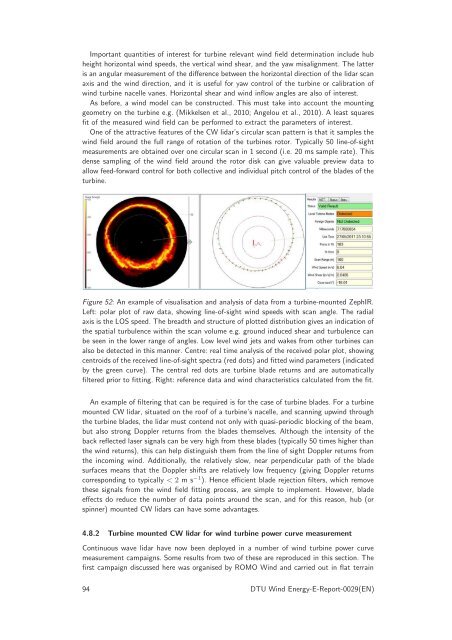Publishers version - DTU Orbit
Publishers version - DTU Orbit
Publishers version - DTU Orbit
You also want an ePaper? Increase the reach of your titles
YUMPU automatically turns print PDFs into web optimized ePapers that Google loves.
Important quantities of interest for turbine relevant wind field determination include hub<br />
height horizontal wind speeds, the vertical wind shear, and the yaw misalignment. The latter<br />
is an angular measurement of the difference between the horizontal direction of the lidar scan<br />
axis and the wind direction, and it is useful for yaw control of the turbine or calibration of<br />
wind turbine nacelle vanes. Horizontal shear and wind inflow angles are also of interest.<br />
As before, a wind model can be constructed. This must take into account the mounting<br />
geometry on the turbine e.g. (Mikkelsen et al., 2010; Angelou et al., 2010). A least squares<br />
fit of the measured wind field can be performed to extract the parameters of interest.<br />
One of the attractive features of the CW lidar’s circular scan pattern is that it samples the<br />
wind field around the full range of rotation of the turbines rotor. Typically 50 line-of-sight<br />
measurements are obtained over one circular scan in 1 second (i.e. 20 ms sample rate). This<br />
dense sampling of the wind field around the rotor disk can give valuable preview data to<br />
allow feed-forward control for both collective and individual pitch control of the blades of the<br />
turbine.<br />
Figure 52: An example of visualisation and analysis of data from a turbine-mounted ZephIR.<br />
Left: polar plot of raw data, showing line-of-sight wind speeds with scan angle. The radial<br />
axis is the LOS speed. The breadth and structure of plotted distribution gives an indication of<br />
the spatial turbulence within the scan volume e.g. ground induced shear and turbulence can<br />
be seen in the lower range of angles. Low level wind jets and wakes from other turbines can<br />
also be detected in this manner. Centre: real time analysis of the received polar plot, showing<br />
centroids of the received line-of-sightspectra (red dots) and fitted wind parameters (indicated<br />
by the green curve). The central red dots are turbine blade returns and are automatically<br />
filtered prior to fitting. Right: reference data and wind characteristics calculated from the fit.<br />
An example of filtering that can be required is for the case of turbine blades. For a turbine<br />
mounted CW lidar, situated on the roof of a turbine’s nacelle, and scanning upwind through<br />
the turbine blades, the lidar must contend not only with quasi-periodic blocking of the beam,<br />
but also strong Doppler returns from the blades themselves. Although the intensity of the<br />
back reflected laser signals can be very high from these blades (typically 50 times higher than<br />
the wind returns), this can help distinguish them from the line of sight Doppler returns from<br />
the incoming wind. Additionally, the relatively slow, near perpendicular path of the blade<br />
surfaces means that the Doppler shifts are relatively low frequency (giving Doppler returns<br />
corresponding to typically < 2 m s −1 ). Hence efficient blade rejection filters, which remove<br />
these signals from the wind field fitting process, are simple to implement. However, blade<br />
effects do reduce the number of data points around the scan, and for this reason, hub (or<br />
spinner) mounted CW lidars can have some advantages.<br />
4.8.2 Turbine mounted CW lidar for wind turbine power curve measurement<br />
Continuous wave lidar have now been deployed in a number of wind turbine power curve<br />
measurement campaigns. Some results from two of these are reproduced in this section. The<br />
first campaign discussed here was organised by ROMO Wind and carried out in flat terrain<br />
94 <strong>DTU</strong> Wind Energy-E-Report-0029(EN)

















